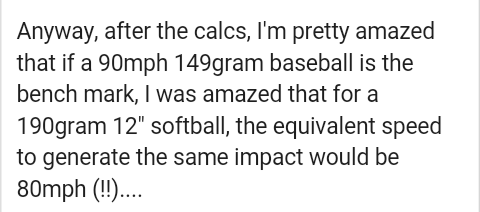actually the velocity is faster, velocity is velocity, the reaction times are fairly equivalent, because the ball is travelling less overall distance. This does NOT mean the ball slows down to the typical softball speed by the time it reaches the plate. It simply means, that because of the shorter distance to cover, the batters reaction time to a 70 mph pitch from 43 is equivalent to a 100 mph pitch from 6? feet.
velocity = distance / time
reaction time = distance / velocity
This ^^^. 100mph does not equal 70mph when you are comparing velocities. Equivalent reaction time based on the different pitching distances is a different topic.





